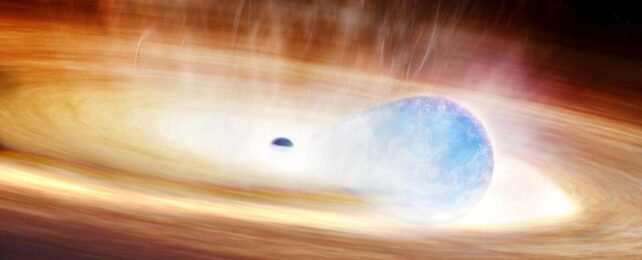In 2023, astronomers recorded one of the most extraordinary space explosions they had ever seen.
It took place some 750 million light-years away, flaring into the detectors of the Zwicky Transient Facility on 7 July. At first, it looked just like a normal supernova – the explosive death of a star – and astronomers named it SN 2023zkd.
Six months later, a search for cosmic anomalies flagged the explosion as a little odd. A look back at data collected since its initial discovery revealed SN 2023zkd had done something really weird: it brightened again.
Related: Space Could Be Littered With Eerie Transparent Stars Made Entirely of Bosons
A new analysis offers up an absolutely Bizarro explanation: this strange sequence of events could be the result of a giant star trying to swallow a black hole like it's from Rand McNally.

"Our analysis shows that the blast was sparked by a catastrophic encounter with a black hole companion, and is the strongest evidence to date that such close interactions can actually detonate a star," says astronomer Alexander Gagliano of the NSF Institute for Artificial Intelligence and Fundamental Interactions.
Supernovae can happen in quite a variety of ways. They usually (but not always) involve the death of a massive star or the runaway thermonuclear explosions on a white dwarf. They're also relatively common, popping up across the Universe at a rate of a few hundred observable ones per year.
Astronomers know more or less how they should play out: a flare of light that bursts onto the scene, followed by a gradual dimming that follows a pretty predictable curve over the ensuing weeks and months.
Initial observations of SN 2023zkd looked relatively typical; a flare recorded by Zwicky was indicative of the early stages of a supernova. Then in January 2024, a tool designed to find unusual events in archives noted it was worth a second look.
Data from different observatories around the world trained on the location had recorded the typical, fading lightcurve. Then it happened: 240 days after Zwicky discovered the event, it brightened again, nearly to the same level as the initial supernova.
That's not something that most supernovae do, so Gagliano and his colleagues turned to archival observations of that sector of the sky to see if any behavior prior to the Zwicky detection could yield any clues, using machine learning to pick up signals humans might miss.
They found that, for more than four years prior to the explosion, the object had been steadily brightening, with some strange fluctuations. This sort of long-term behavior isn't typical of stars about to explode.
The scenario closest to the observations, the researchers determined, involved a massive dying star and a compact object such as a black hole, locked in a tight orbit. As they whirled around each other in a decaying orbit, the star shed a great deal of its mass, which in turn started to glow.
Eventually, the researchers believe, the two objects drew close enough together that the star exerted its gravitational pull to subsume the black hole; however, the gravitational pull exerted by the black hole stressed the star to such a degree that it triggered a supernova.

The first peak in brightness was from the blast of the supernova colliding with low-density gas around the system. The second peak was from a slower, more sustained collision with the thick cloud of material ejected by the star in its final years. The strange fluctuations prior to the explosion were indicative of a system stressed by the presence of a black hole.
This is not as impossible as it might sound. A black hole only has as much gravity as a star of comparable mass; if you're at a reasonable distance, as you would be for a star, things behave the same way. However, a black hole is so compact that you can get much closer, to the point where you would be inside a star of comparable mass, the strength of its gravitational field increasing as you go.
The Sun, for instance, is about 1.4 million kilometers (865,000 miles) across. The event horizon of a black hole with the same mass as the Sun is about 6 kilometers across.
So, if the star in the binary had a greater mass than the black hole, then it would be considered that the star pulled the black hole in, before the black hole's extreme close gravity brought the star to a sticky end. The other possibility is that the black hole completely devoured the star before it could explode; both scenarios exhibit the same collision with the material around the system.
Either way, the end result is a bigger black hole.
"We're now entering an era where we can automatically catch these rare events as they happen, not just after the fact," Gagliano says. "That means we can finally start connecting the dots between how a star lives and how it dies, and that's incredibly exciting."
The research is due to be published in The Astrophysical Journal, and a preprint is available on arXiv.
